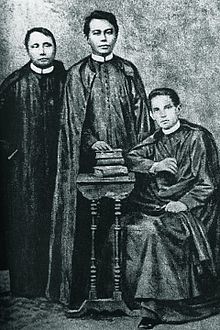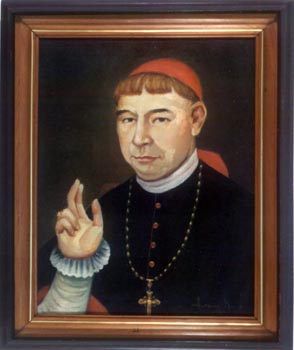In OTL, the title of Count of Manila was awarded by Isabela II of Spain to Narciso Claveria, governor-general of the Philippines after he successfully defeated the pirates at Balanguigui. And starting today, the previous sched shall be scrapped, so updates shall mostly come from weekends or if I have no schoolworks left.
The Taguima crisis
Jean-Baptiste Thomas Médée Cécille, the commander during the Basilan blockade
By the 1840s, other European powers began to take an interest in Southeast Asia, which was still mostly independent. The French in particular had set its sights on Basilan, which they called
Taguime, derived from its older name, Taguima.
Due to the conclusion of the Opium War in British victory, as well as to access China from the south and to protect French missionaries from Vietnamese persecution, the French tried to seize Basilan to transform it into an Hong Kong of theirs, but had failed due to local resistance as well as protection from Manila in 1843. They would try again, this time somewhat succeeding as they forced the Basilan datus to sign a treaty on January 13, 1845, following the occupation his 1844. On February 20, they forced the Sulu sultan to formally cede Basilan to the French, transforming it as their colony.
In response to these developments, the successor of Varela, Hermengildo Araneta (t. 1841-1850) gathered the Imperial Assembly to declare a formal document threatening war with France if ever they would formally annex the territory, as well as others concerned.
Meanwhile, the people of Basilan remained wholly loyal to Manila, as recognized by their hostility with the French and with strong resistance from all over the island, Christian, Muslim, Visayan and Moro alike had united to oppose foreign rule over their lands. Ultimately, France withdraw on August 5, 1845, ending the temporary French foray in the Sulu archipelago.
Due to their loyalty and desire to remain independent, Juan I praised the resiliency of the island's inhabitants, uttering the phrase:
El pueblo mas leal que los hermanos musulmanes de Filipinas habian vista jamas. This diplomatic victory, first achieved by an Asian power, increased the Philippines' prestige abroad, as well that of Juan's. It also tarnished France's reputation in the Philippines, which would focus on strengthening ties with whatever unified German state shall emerge in the future alongside Britain's. A brief expedition by the Americans followed, but they would later left to prevent more provocation. It also paved the way to Sulu becoming a protectorate much later.
Piratical liquidation at Balanguigui
A major event in 1840s Philippines, as well as one the most famous and successful, was the expedition to Balanguigui, which was a fatal blow to the piratical activities of the Moros in Sulu, and the fall of Sulu as a Philippine protectorate.
Since at least the 15th century piracy was widespread in the Sulu Sea and in the waters surrounding it, therefore having a negative effect on trade in the region. It was also the main source of wealth by the Suluans as they were also the main merchants in the area and that different countries had came by to trade and buy some goods in the area from Chinese or other Muslims. Slavery was also common, of which many, were Visayan so that European observers had noted that they were the majority of all inhabitants in the Sultanate. Their counterpart, Maguindanao also had slaves but overtime that characteristic was slowly fading as their maritime power waned over the years.
Determined to destroy piracy once and for all, Araneta ordered an expedition to be mounted to the islands with preparations made on late January.
The landing at Balanguigui
On February 16, 1848 the Philippine navy departed from its respective ports in Luzon and Visayas, bound for the Sulu sea. They otherwise reached the Sulu archipelago that same day. Taking advantage of the low tide, they landed, assaulted and successfully captured Fort Balanguigui although they first struggled and had grappling hooks utilized to take them.
On the same day as the capture of F. Balanguigui, they went to F. Sipac next to try advancing and take the island, but the waters were not enough. So the forces, led by Jose Joaquin de Ynchausti, son of the elder Ynchausti ordered a reconnaissance of the fort and realized that the naval forces could not approach to surround it, so he gave orders for caliber mountain howitzers to be deployed on the isthmus. At dawn on the 19th the naval forces took their positions. They opened fire at 7:00 AM, at the same time as the land batteries. This was also successful, following a mass suicide of the pirates by either killing their families or charging against the bayonets. Over 150 were captured by the Filipinos and was sent to a field hospital. A smaller fort which became a nuisance for the Filipinos was entrusted by some captains, who captured it bloodlesly.
The last fort was captured swiftly on February 21, as the men garrisoning it had no military experience and thus, immediately fled. This was later celebrated by a naval gun salute upon Ynchausti's return to Manila, followed by a celebratory procession of the Our Lady of La Naval in Intramuros. Ynchausti was granted the title
Count of Manila for his service.
Prelude and war against Bago
The Sultanate of Pinagurasan (named after its capital of the same name[2]), more famously known as the Domain of Datu Bago, was established initially first as a vassal of the more influential Maguindanao sultanate in the 1800s. By 1830, his combined army of Bagobos, Manobos and Moros have conquered the entirety of the Davao Gulf and it's coastal territories, and due to this immense power and influence, he was crowned sultan by 1843, virtually separating it from Maguindanao's sphere of influence as an independent state.
Bust of Datu Bago of Pinagurasan
As early as 1842, the Filipinos attempted to foray, landing at Sigaboy[3] and immediately demanded heavy tribute from the locals, which resulted in the natives calling Bago to expel the newcomers. From then on, the sultanate became a tempting target for Manila, primarily due to its prosperous maritime trade there.
Nevertheless, the government under Araneta would have to find a way to justify the conquest of this vital region, of whom Araneta called "a necessity for expansion of maritime trade". He believed it would be vital for the settlement of the region. Before this plausible and inevitable conquest, Araneta ordered the settlement of the already controlled Caraga, which was recently separated from Misamis. Only few as 4,000 settled since it was still mostly forest and that it had deadly diseases such as malaria. This turned the government to reduccion, where some Lumads willingly settled in the forests and cleared to pave way for lands. One successful thing however, is that they were able to establish a road from Butuan to the Davao coast, where it would be used as a major route for conquest and trade.
The perfect opportunity came when the trading vessel San Rufo, which was heading its way to Maguindanao for a peace treaty was captured, burned, and had all of its crew murdered by the orders of Bago. Using this as casus belli, the Filipinos asked Maguindanao, which by this point was a close ally and protectorate of the Empire, to disown the Pinagurasnons, who finally let Bago's domain go since by this point they had zero authority of them in 1846. With this, combined with the outrage of the massacre, Araneta ordered the mobilization of men to conquer the area.
The one who would led the conquest was the Spanish migrant Jose Cruz de Uyanguren, a Basque from the region of Guipuzcoa, who was to be governor and have a monopoly over trade in a decade, accompanied by Ynchausti who would launch a series of attacks on Bago's navy. Pule also prepared his semi-military order to join the Ynchausti-Uyanguren army to facilitate Christianity among the natives, accompanied by seculars and friars alike. Before the official start of war, on March 1848 the force had 10 regiments (San Jose, Parang, Maypajo, Cacao, Lacancale, Tinajeros, Tibag, San Ignacio, Laureana and La Tierra, with 1,000 each) numbering 10,000, and a naval fleet of 3 (5 steamboats and, 10 karakoas and 10 vintas each), along with the 1,000 knights of San Jose.
The attack on the San Rufo, 1846
The Imperial Assembly formally declared war on April 1848, which had mass support from all over the Philippines. Uyanguren and Pule's knights have landed on the Davao river's estuary, in an attempt to capture Pinagurasan to end the war.
Meanwhile Ynchausti captured all coastal towns and destroyed pirate fleets with ease. In the meantime, missionaries were also sent to the area once Ynchausti sent them news regarding the liquidation of piracy in the region.
The war itself was merely brief, as at first the Filipinos' attacks on Pinagurasan backfired due to heavy Lumad and Moro resistance. However, it was Bago's heavy taxation among other Lumad tribes that would cost him his independence and state. A local datu, named Daupan, requested an alliance with Uyanguren, since the two datus were petty rivals. The Filipinos were more than happy to accept this alliance, since resistance was getting stronger everyday. However, they were repelled by Bago's sucjects, resulting in an inconclusive battle that lasted until June where additional reinforcements from Zamboanga sailed to Davao, which ensured the takeover of the settlement of Pinagurasan. Bago fled to the village of Hijo northwards to evade capture.
On June 29, 1848, Uyanguren founded the settlement of Nueva Vergara[4], named after his hometown in Spain. The newly conquered territory was initially part of the military commandancy of Caraga. Pinagurasan was transformed into a barrio of the new municipality. Christianization immediately started after the conquest, where it had a difficult time converting the locals into Christianity. To act an action of reconciliation, Uyanguren, with Juan I's permission to nominate him as the primary leader of all Lumads and Moros in the area, and the cabeza de barangay of the now barrio of Pinagurasan, until his death in 1850. Uyanguren later found himself replaced since his plans for a positive economic sway of the region backfired. Nueva Vergara would later be renamed to Davao in 1867.
All of these three events had massively increased the popularity of Juan I and Araneta, cementing them upon the list of greatest statesmen to ever exist by the Filipinos. By the time the Balanguigui raid was conducted in 1849, Juan was already 24 years old, therefore earning him the moniker "the great", the first Filipino to take such one, due to these continuous victories, and his following reforms in the next years.
[1] - Only consisted of the city proper before the 1930s
[2] - Area from present-day Generoso Bridge in Bangkerohan to Quezon Boulevard more than a kilometer down south
[3] - Now Governor Generoso (as of the 1980s?)
[4] - Only consisted of the poblacion district












